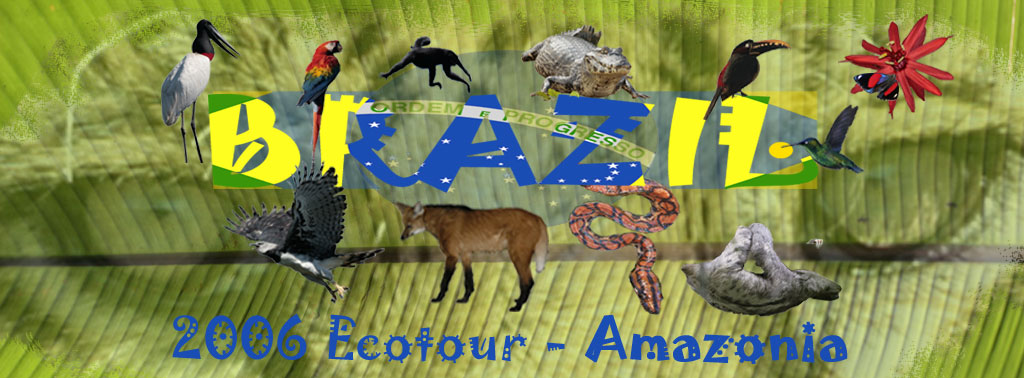



Added 3 September 2006
Day 13: Sunday, June 18, 2006
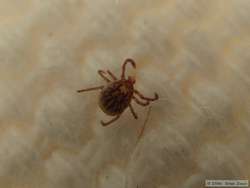 Shan had a rough night last night. She kept getting bit by bugs and ticks and was up a lot during the night. At one point I got up and had to scrape a couple of ticks (or something) off of her back. She said they hurt really bad.
Shan had a rough night last night. She kept getting bit by bugs and ticks and was up a lot during the night. At one point I got up and had to scrape a couple of ticks (or something) off of her back. She said they hurt really bad. 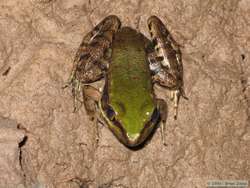 At any rate, between the humidity, the cold showers, and the bugs at night, but especially the bugs at night, Shan is getting pretty weary, and she commonly takes naps during the day here. But mostly, she's is stressing a bit about the bugs in her bed.
At any rate, between the humidity, the cold showers, and the bugs at night, but especially the bugs at night, Shan is getting pretty weary, and she commonly takes naps during the day here. But mostly, she's is stressing a bit about the bugs in her bed.
We had a very early start today. We met down at the boat dock at five o'clock in the morning. Shan and I were the first ones to arrive for a change, so I scoped the docks out for any interesting herps. I found one small frog that I still have to try to identify. We were on the water shortly after five, and headed up the river, with barely enough light to see by.
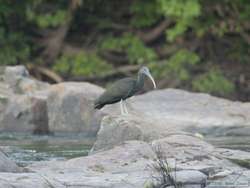 The reason why we were moving so early is that we had to cover about 36 kilometers of river by around 7 o'clock so that we could see some hoatzin (Opisthocomus hoazin), a bird that would look quite normal next to a dinosaur. We figured we'd see other great things along the way as well, and we weren't disappointed.
The reason why we were moving so early is that we had to cover about 36 kilometers of river by around 7 o'clock so that we could see some hoatzin (Opisthocomus hoazin), a bird that would look quite normal next to a dinosaur. We figured we'd see other great things along the way as well, and we weren't disappointed. 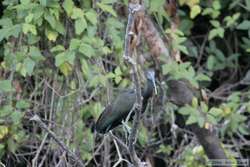 As the morning lightened, but before the sun came up, we saw a tapir (Tapirus terrestris) in the river near shore. We didn't get to see it for long, but we got a pretty good look at it, at least the upper half of it, as it was in the water along the shore. As Fernando spun the boat around, we saw it go under water, but by the time we made it back around, it had come up the bank and bolted into the forest, not to be seen again.
As the morning lightened, but before the sun came up, we saw a tapir (Tapirus terrestris) in the river near shore. We didn't get to see it for long, but we got a pretty good look at it, at least the upper half of it, as it was in the water along the shore. As Fernando spun the boat around, we saw it go under water, but by the time we made it back around, it had come up the bank and bolted into the forest, not to be seen again.
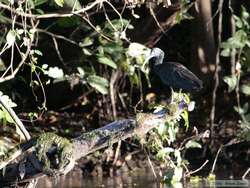 As dawn came, we saw more birds, including many we'd already seen, but also some notable new ones such as the american pygmy kingfisher (Chloroceryle aenea), which is not much bigger than a large hummingbird, and what we think were red-shouldered macaw (Ara nobilis). We also saw green ibis (Mesembrinibis cayennensis), which is a beautiful bird that we only saw a couple of times, both before the sun had come up, so I couldn't get any really nice photographs of them.
As dawn came, we saw more birds, including many we'd already seen, but also some notable new ones such as the american pygmy kingfisher (Chloroceryle aenea), which is not much bigger than a large hummingbird, and what we think were red-shouldered macaw (Ara nobilis). We also saw green ibis (Mesembrinibis cayennensis), which is a beautiful bird that we only saw a couple of times, both before the sun had come up, so I couldn't get any really nice photographs of them.
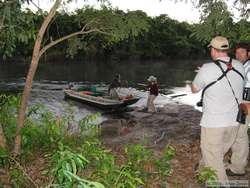 Since the water level of Rio Cristalino is so low, there are a few places where it is tricky to get the motorboat through. At one such spot, either to lighten the boat or because it is seen as too dangerous, we all had to get out of the boat and walk past a set of mild rapids as Fernando piloted the boat through them. Then we all piled back in the boat and continued toward the hoatzin.
Since the water level of Rio Cristalino is so low, there are a few places where it is tricky to get the motorboat through. At one such spot, either to lighten the boat or because it is seen as too dangerous, we all had to get out of the boat and walk past a set of mild rapids as Fernando piloted the boat through them. Then we all piled back in the boat and continued toward the hoatzin.
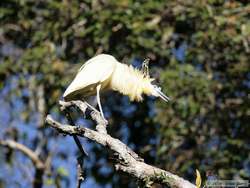
|
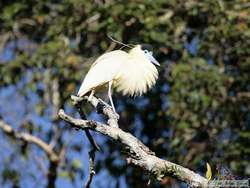
|
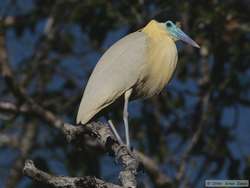
|
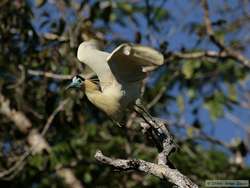
|
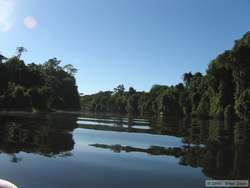
|
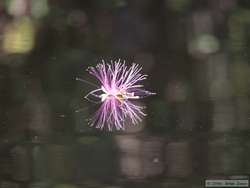
|
At around seven o'clock, we arrived at a couple of oxbow lakes where the hoatzin are known to congregate. Like many things in this area seem to be, they were very secretive, and liked to stay hidden in the thick foliage. 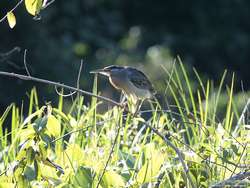
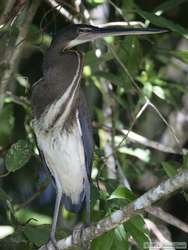 I got a couple of brief good looks at the different parts of several hoatzin, and was able to piece together a whole one in my mind. I don't think anyone else was quite as impressed or excited about seeing the hoatzin as I was. While searching for the hoatzin, we happened upon an agami heron (Agamia agami), which is very rare.
I got a couple of brief good looks at the different parts of several hoatzin, and was able to piece together a whole one in my mind. I don't think anyone else was quite as impressed or excited about seeing the hoatzin as I was. While searching for the hoatzin, we happened upon an agami heron (Agamia agami), which is very rare.  It was only the second one that Fabricio had ever seen, and he said that people come here just to see this heron. Apparently we were the only clueless ones regarding this bird, because everyone back at the lodge was asking about our agami heron sighting. It was like we'd seen Elvis, or something. Die-hard birders are a strange bunch.
It was only the second one that Fabricio had ever seen, and he said that people come here just to see this heron. Apparently we were the only clueless ones regarding this bird, because everyone back at the lodge was asking about our agami heron sighting. It was like we'd seen Elvis, or something. Die-hard birders are a strange bunch.
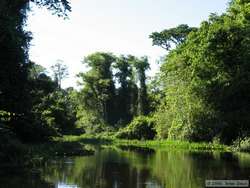
|
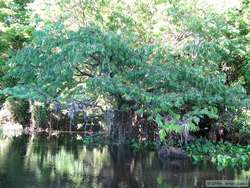
|
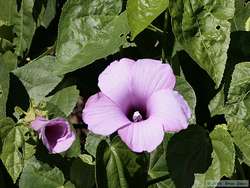
|
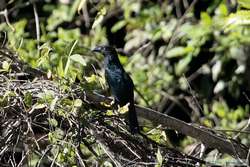
|
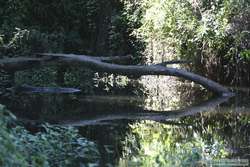
|
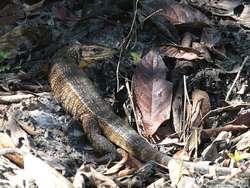
|
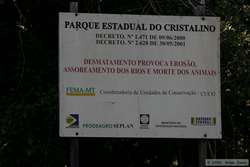 We picked up several other new birds while floating around there. On the way back to the lodge, still more new birds, plus a golden tegu lizard (Tupinambus teguixin), and a pair of capybara (Hydrochaeris hydrochaeris). Fabricio said that capybara can hold their breath and stay underwater for up to an hour.
We picked up several other new birds while floating around there. On the way back to the lodge, still more new birds, plus a golden tegu lizard (Tupinambus teguixin), and a pair of capybara (Hydrochaeris hydrochaeris). Fabricio said that capybara can hold their breath and stay underwater for up to an hour.
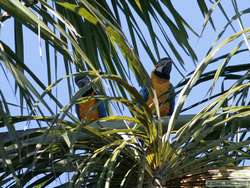
|
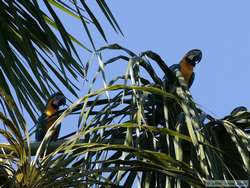
|
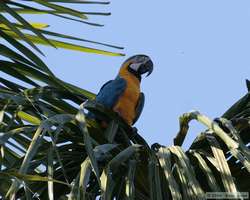
|
We also got to see our first bats of the trip. I'm pretty sure they were White-lined Sac-winged Bats (Saccopteryx spp.)
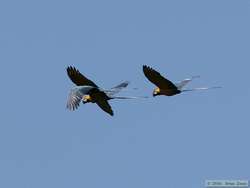
|
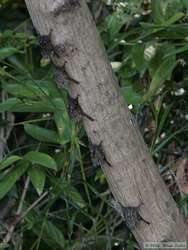
|
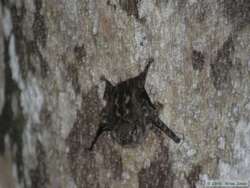
|
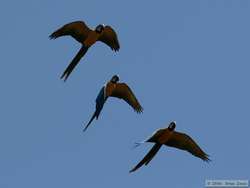
|
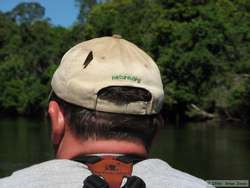
|
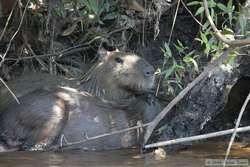
|

|

|
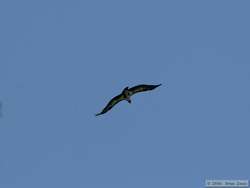
|
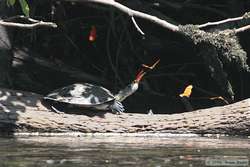
|
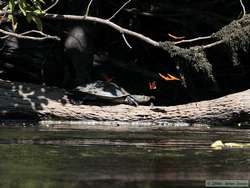
|
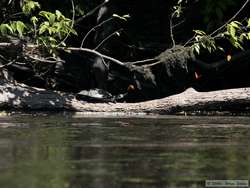
|
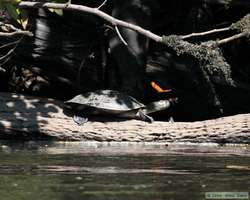
|
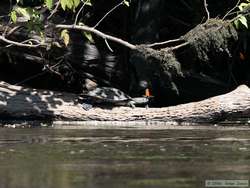
|
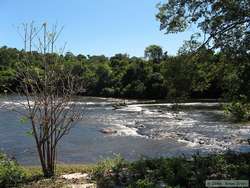
|
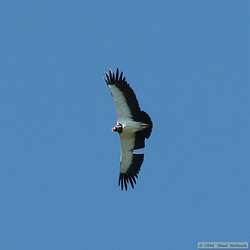
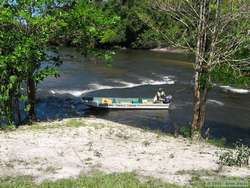 Once again, we had to get out of the boat so that Fernando could go through the rapids without us.
Once again, we had to get out of the boat so that Fernando could go through the rapids without us.
We got back to the lodge not long before lunch, and after lunch I went back and forth between watching Brazil beat Australia 2-0 in World Cup play and the library, where I was waiting for Wil, one of the few people here interested in herps, to chill the snakes he caught the previous day for photos. 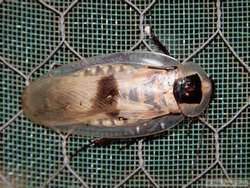 He ended up not doing it, so after the game I sat in the library and tried to identify some of the butterflies I got pictures of. I think I actually got a few of them, but after a while I got frustrated and went back to the room. Butterflies are extremely difficult to identify, partially because there are so many that look similar, and I think partially because they aren't as popular (and therefore not as well studied) as birds.
He ended up not doing it, so after the game I sat in the library and tried to identify some of the butterflies I got pictures of. I think I actually got a few of them, but after a while I got frustrated and went back to the room. Butterflies are extremely difficult to identify, partially because there are so many that look similar, and I think partially because they aren't as popular (and therefore not as well studied) as birds.
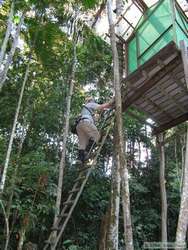
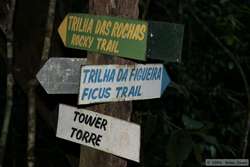 Before dinner, we did another hike in the jungle, ending up at the Saliero House, but the forest was extremely quiet, and all I saw was either the plum-throated (Cotinga maynana) or spangled cotinga (Cotinga cayana), and a couple of other birds we couldn't identify. I had really hoped for a better last night for Chuck and Dave.
Before dinner, we did another hike in the jungle, ending up at the Saliero House, but the forest was extremely quiet, and all I saw was either the plum-throated (Cotinga maynana) or spangled cotinga (Cotinga cayana), and a couple of other birds we couldn't identify. I had really hoped for a better last night for Chuck and Dave.
Species list for the day (36 birds, 3 mammals, 2 reptiles, 2 amphibians):
Anhinga (Anhinga anhinga)
Capped Heron (Pilherodius pileatus)
Striated Heron (Butorides striatus)
Agami Heron (Agamia agami)
Green Ibis (Mesembrinibis cayennensis)
King Vulture (Sarcoramphus papa)
Black-collared Hawk (Busarellus nigricollis)
Slate-colored Hawk (Leucopternis schistaceus)
Red-throated Caracara (Daptrius americanus)
Bat Falcon (Falco rufigularis)
Sunbittern (Eurypyga helias)
Ruddy Pigeon (Columba subvinacea)
Blue-and-yellow Macaw (Ara ararauna)
Scarlet Macaw (Ara macao)
Red-shouldered Macaw (Ara nobilis)
Green-cheeked Parakeet (Pyrrhura molinae )
Little Cuckoo (Piaya minuta)
Hoatzin (Opisthocomus hoazin)
Greater Ani (Crotophaga major)
Blackish Nightjar (Caprimulgus nigrescens)
White-necked Jacobin (Florisuga mellivora)
Amazon Kingfisher (Chloroceryle amazona)
Green Kingfisher (Chloroceryle americana)
Green-and-rufous Kingfisher (Chloroceryle inda)
American Pygmy Kingfisher (Chloroceryle aenea)
Brown Jacamar (Brachygalba lugubris)
Black-fronted Nunbird (Monasa nigrifrons)
Channel-billed Toucan (Ramphastos vitellinus)
Black-banded woodcreeper (Dendrocolaptes picumnus)
E Glossy Antshrike (Sakesphorus luctuosus)
Screaming Piha (Lipaugus vociferans)
Social Flycatcher (Myiozetetes similis)
White-winged Swallow (Tachycineta albiventer)
White-banded Swallow (Atticora fasciata)
Southern Rough-winged Swallow (Stelgidopteryx ruficollis)
Red-capped Cardinal (Paroaria gularis)
White-lined Sac-winged Bats (Saccopteryx spp.)
Brazilian Tapir (Tapirus terrestris)
Capybara (Hydrochaeris hydrochaeris)
Golden Tegu lizard (Tupinambus teguixin)
South American River Turtle (Podocnemis spp.)
Amazon Racerunner aka Green Ameiva (Ameiva ameiva)
Amazon River Frog (Rana palmipes)
Geckos (Family Gekkonidae )
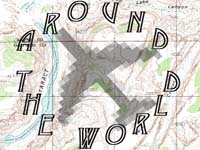 |
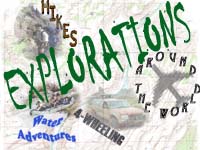 |